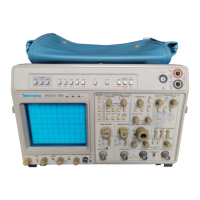Applications
Phase Difference Between Two Signals
1.
Using either probes or cables with equal time delays, display the reference
signal on
CH
1 and the comparison signal on
CH
2.
For higher frequencies,
signal delay matching is more critical. The procedure for matching delays
is
found under "Matching Channel 2 Delay"
in
Section
4.
2.
Set
CH
1 and
CH
2 VOLTS/DIV and VAR controls
to
obtain equal
amplitudes
of the reference and the comparison signals. Set the amplitudes
as large as
is
practical.
3.
Set Vertical POSITION controls
to
center both displays vertically. Phase
measurement accuracy depends on the accuracy of
vertical centering.
4.
Set SEC/DIV and VAR to display one cycle of the reference signal over five
horizontal divisions.
5.
Activate
1/~t
by
pressing both the
~t
and
~V
buttons together.
6.
Align the Reference cursor with a zero-crossing
of
the reference signal.
Align
the Delta cursor with the nearest zero-crossing of the comparison
Signal, on the same slope
as
the,reference
Signal
zero-crossing (see Figure
3-6). Use the center horizontal
graticule line as the reference for aligning the
zero-crossings.
7.
Read phase shift
in
degrees from the CRT readout.
If the phase shift
is
less than 1 horizontal division (72 degrees), you can
improve the accuracy of the measurement. Use the
X10 MAGnifier, without
changing
SEC/DIV or VAR,
to
expand the display; align the cursors with the zero
crossings; and divide the
PHASE readout by 10 (see Figure 3-7).
Measuring Millivolt Signals
With the standard, 1 OX-attenuation probes, deflection factors range down to
20
mV/division. To increase the vertical sensitivity by a factor of ten, either use a
1X probe or cascade
CH
2 with
CH
1.
To obtain 200 /LV/division, use a 1X probe
or
coaxial cable
to
connect the signal to
CH
2 and cascade
CH
2 with
CH
1.
To
cascade
CH
2 with
CH
1:
1.
Connect the
CH
2 output on the rear panel, through a 50-0 cable, to the
CH
1 input on the front panel.
2.
Set the
CH
1 input at 1
MO
DC
or AC.
3.
Set 20 MHz BW LIMIT on. This will reduce the trace "thickening" caused
by wide-band noise and avoid oscillation of the
vertical system. If you
trigger from
CH
1 source, you probably need
to
use
HF
REJ
coupling.
4.
Set
CH
2 VOL TS/DIV at 2 mV (20 mV with 10X probe) and set
CH
1 at
5 mV or 2 mV/division.
5.
Note that the
CH
1 scale factor and delta-volts readings agree with the
signal at the
CH
2 probe-tip with a 10X probe. With a 1 X probe, the scale
factor and delta-volts readings should
be
divided by ten.
2465A/2455A/2445A Operators
3-11

